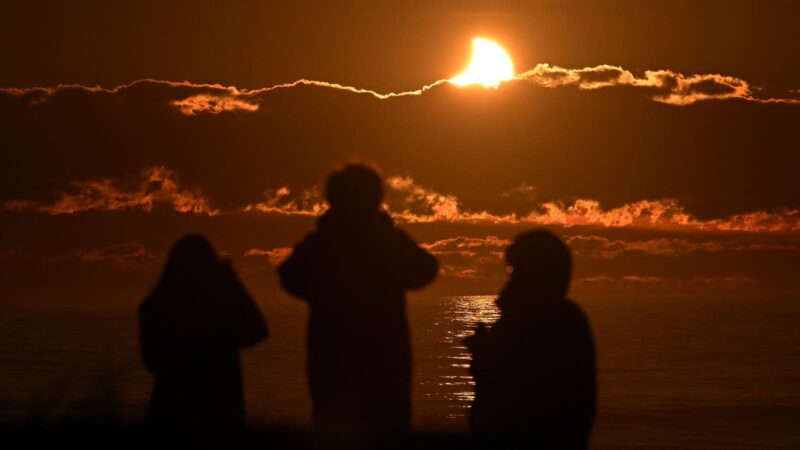Topline
Early risers in New Zealand and the South Pacific were able to capture the rare sight of a partially eclipsed sunrise just hours before September’s equinox. A deep partial solar eclipse covered up to 86% of the sun as seen from southern New Zealand and Antarctica, creating a dramatic partial eclipse in a year without a total solar eclipse.
People watch a partial solar eclipse at New Brighton, a coastal suburb of Christchurch, on September 22, 2025. A solar eclipse occurs when the moon passes between Earth and the sun, casting a shadow on our planet. The sun appeared as a crescent due to this partial eclipse. In New Zealand, coverage ranges were about 60% in the north island and more than 70% in the south island. This solar eclipse was visible to parts of the Pacific, Atlantic, Australia and Antarctica. (Photo by Sanka Vidanagama / AFP) (Photo by SANKA VIDANAGAMA/AFP via Getty Images)
AFP via Getty Images
Key Facts
On Sept. 22, 2025, a deep partial solar eclipse rose over New Zealand, Antarctica and the South Pacific, with those farthest south seeing a larger eclipse during sunrise.
The eclipse was also unusually deep for a partial, with the Moon’s penumbral shadow covering much of the South Pacific. In southern New Zealand and Antarctica’s Ross Sea, up to 86% of the sun was obscured, creating a dramatic crescent sunrise.
The eclipse was streamed live from Dunedin in New Zealand’s South Island, where the sun rose already eclipsed and reached 70% obscuration.
In 2026, there are solar eclipses in February and August, with the latter on Aug. 12 a total solar eclipse visible deom Greenland, Iceland and Spain.
View of a partial solar eclipse at New Brighton, a coastal suburb of Christchurch, on September 22, 2025. (Photo by Sanka Vidanagama / AFP) (Photo by SANKA VIDANAGAMA/AFP via Getty Images)
AFP via Getty Images
Where The Eclipse Was Seen
For observers in New Zealand, the eclipse began before sunrise, with the sun emerging from the horizon already in deep partial eclipse. Antarctica’s remote stations, including McMurdo and Zucchelli Stations, experienced even deeper views. Across the Pacific, from Fiji to Tonga, smaller partial eclipses were recorded, while Tahiti saw a subtle but beautiful 8% coverage after sunrise. Tasmania, Australia, saw a barely noticeable 3% partial solar eclipse.
People watch a partial solar eclipse at New Brighton, a coastal suburb of Christchurch, on September 22, 2025. (Photo by Sanka Vidanagama / AFP) (Photo by SANKA VIDANAGAMA/AFP via Getty Images)
AFP via Getty Images
The Eclipse, Equinox And Auroras
The event occurred less than 24 hours before the September equinox, which marks the day when the midday sun crosses the equator going south to begin autumn in the Northern Hemisphere and spring in the Southern Hemisphere. The geometry of the equinox —when Earth’s tilted axis is side-on to the sun — can mean an increase in the frequency and the intensity of the geomagnetic storms that cause displays of aurora.
View of a partial solar eclipse at New Brighton, a coastal suburb of Christchurch, on September 22, 2025. (Photo by Sanka Vidanagama / AFP) (Photo by SANKA VIDANAGAMA/AFP via Getty Images)
AFP via Getty Images
Looking Ahead To The 2028 Total Solar Eclipse
Some of the locations that saw the partial solar eclipse used it as a warm-up event. For example, Dunedin is in the path of totality during a total solar eclipse on July 22, 2028, when it will experience 2 minutes 47 seconds of totality close to sunset. The path of totality that day will stretch 7,442 miles (11,976 kilometers), crossing the Cocos and Christmas Islands, parts of Western Australia, Northern Territory, Queensland and New South Wales in Australia, and New Zealand’s South Island.
A person watches a partial solar eclipse at New Brighton, a coastal suburb of Christchurch, on September 22, 2025. (Photo by Sanka Vidanagama / AFP) (Photo by SANKA VIDANAGAMA/AFP via Getty Images)
AFP via Getty Images
When Is The Next Solar Eclipse In North America?
Although there is no major solar eclipse in North America for some years, the total solar eclipse on Aug. 12, 2026, will be visible as a partial eclipse from the eastern U.S. coastline.








